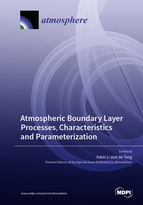Atmospheric Boundary Layer Processes, Characteristics and Parameterization
A special issue of Atmosphere (ISSN 2073-4433). This special issue belongs to the section "Meteorology".
Deadline for manuscript submissions: closed (20 January 2023) | Viewed by 22823
Special Issue Editors
Interests: tropical cyclones; atmospheric boundary layer; air-land-sea interaction; air pollution
Special Issues, Collections and Topics in MDPI journals
Interests: tropical cyclone boundary layer; typhoon field experiment; extratropical transition
Special Issues, Collections and Topics in MDPI journals
Special Issue Information
Dear Colleagues,
The atmospheric boundary layer is distinguished from the rest of the atmosphere due to its unique characteristics, i.e., direct interaction with the Earth’s surface and active turbulence. Understanding the dynamic and chemical processes in the boundary layer is of great importance in weather and air quality forecasting. Recently, with the improvement of observation and simulation techniques, our understanding of atmospheric boundary layer processes and characteristics has significantly improved. For example, the ultrasonic anemometer and large aperture scintillometer can provide information around turbulent exchanges, while the large eddy simulation technique simulates the detailed structure of turbulent eddies. This Special Issue is dedicated to reporting new findings with regard to atmospheric boundary layer processes, characteristics, and parametrization methods, including but not limited to turbulent exchange, transportation, and their parametrization; boundary layer jet; local atmospheric circulation; surface energy partitioning; atmospheric stability condition; pollutant distribution and transportation; etc.
Prof. Dr. Yubin Li
Prof. Dr. Jie Tang
Guest Editors
Manuscript Submission Information
Manuscripts should be submitted online at www.mdpi.com by registering and logging in to this website. Once you are registered, click here to go to the submission form. Manuscripts can be submitted until the deadline. All submissions that pass pre-check are peer-reviewed. Accepted papers will be published continuously in the journal (as soon as accepted) and will be listed together on the special issue website. Research articles, review articles as well as short communications are invited. For planned papers, a title and short abstract (about 100 words) can be sent to the Editorial Office for announcement on this website.
Submitted manuscripts should not have been published previously, nor be under consideration for publication elsewhere (except conference proceedings papers). All manuscripts are thoroughly refereed through a single-blind peer-review process. A guide for authors and other relevant information for submission of manuscripts is available on the Instructions for Authors page. Atmosphere is an international peer-reviewed open access monthly journal published by MDPI.
Please visit the Instructions for Authors page before submitting a manuscript. The Article Processing Charge (APC) for publication in this open access journal is 2400 CHF (Swiss Francs). Submitted papers should be well formatted and use good English. Authors may use MDPI's English editing service prior to publication or during author revisions.
Keywords
- atmospheric boundary layer
- turbulent exchange
- boundary layer jet
- local atmospheric circulation
- surface energy partitioning
- pollutant transportation







